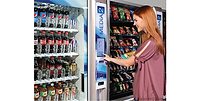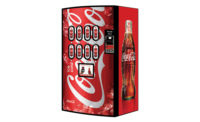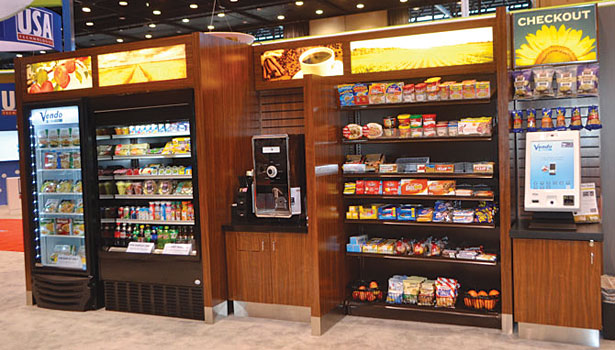New vending technology makes channel a destination
Micro markets emerge as vending channel offshoot

New-age vending machines, like Coca-Cola’s Small World Machine, are becoming destination points that offer interactive beverage purchasing experiences. (Image courtesy of The Coca-Cola Co.)

Vending machines are incorporating technology that allows consumers to learn more about products, make selections via touchscreens, make multiple purchases at once, and pay with a credit or debit card. (Image courtesy of Crane Payment Innovations)

Micro markets allow the vending channel to offer a wider variety of products and appeal to a larger crowd, says SandenVendo’s Jennifer Elizondo. SandenVendo announced its entrance into the micro market sector at the 2014 NAMA OneShow. (Image courtesy of SandenVendo America Inc.)



Last spring in Lahore, Pakistan, and New Delhi, India, Coca-Cola vending machines connected consumers in the two communities separated by 325 miles and decades of political tension. The touchscreen machines by Atlanta-based The Coca-Cola Co. invited consumers to make a friend in the other community, “join hands,” and work together to draw a shape or do a dance to earn a can of Coca-Cola. In other places around the world, Coca-Cola vending machines have encouraged fans to trade hugs, smiles, Christmas carols and dance moves or complete James Bond missions for a can of Coca-Cola.
New technologies have transformed vending machines into destinations with experiences, as opposed to quick opportunities to buy a beverage, says Chuck Reed, director of marketing and sales operations support for Crane Payment Innovations (CPI), Malvern, Pa. Large touchscreens enable vending machines to display anything from advertising and promotions to caloric information to games that entice consumers to walk up to the machine and interact with it, he says. As a result, he expects companies that invest in this technology to see significant sales lifts.
This touchscreen technology helps the industry keep up with consumer trends, says Mark Giroux, national sales director for Coinco, St. Louis. “We’ve seen, particularly in the last five or 10 years, that the typical vending consumer is younger and certainly much more technologically capable than previous generations,” he says. “So, machines that interact with the consumer enjoy pretty good sales.”
These younger consumers also are more comfortable paying with credit or debit cards, notes Rinaldo Spinella, executive vice president of Apriva, Scottsdale, Ariz. The company introduced Apriva Campus Solutions, which integrates unattended payments into the campus card structure, to enable students, faculty and staff on university campuses to make cashless purchases at vending machines.
“Technologies like cashless vending offer a number of tangible benefits to each audience,” Spinella says. “For consumers, the convenience of paying by card means that they don’t have to worry about having the proper amount of bills and coins on hand. This gives them the freedom to make purchases where and when they want, which certainly benefits both the beverage company and the operator, each of whom sees a significant uptick in sales with cashless payments.” From a logistical standpoint, cashless payment systems reduce the cost of supporting cash, including the collection, counting and transportation of cash, and shrinks the risk of vandalism and theft, he adds.
According to Roni Moore, vice president of marketing and communications for the National Automatic Merchandising Association (NAMA), Chicago, last year more vending operators embraced new payment technologies than ever before. “The latest state of the industry report cites one example of a 28 percent increase in overall sales for machines with cashless readers, with 11 percent of that from electronic transactions,” she says.
To make vending machine shopping even more convenient, some combination machines offer purchase-with-purchase systems, where a snack and a drink can be purchased together, notes Angela Olson, marketing manager for Seaga, Freeport, Ill. “[This] can be a great way to increase business by simplifying the buying process,” she says.
For example, CPI’s Media platform uses an Internet connection to allow consumers to build a shopping cart to purchase multiple items in one transaction. “Instead of the soccer mom having to swipe the card three times to make three different sports drink purchases, now she can, through the Media platform, build a shopping cart with three distinct drink flavors in it, swipe the card or insert her money once, and get all three at the same time,” Reed explains. Plus, because the machines are connected to the Internet, they also can offer discounts based on multiple purchases or time of day, he adds.
What’s inside
But new buying technology can only take the vending channel so far; the products inside the machine also have to entice consumers.
“I think [operators] need to offer a wider variety of beverages,” Coinco’s Giroux says. “You need not only the traditional carbonated soft drinks — the regular and diet — you need non-carbonated drinks, you need juices, you need other beverages.” As carbonated soft drink sales have been declining in the last 10 years, vending machines have been stocking more bottled water, flavored water and juices, he notes.
Nick Yates, founder of Fresh Healthy Vending, San Diego, says healthy products are a fast-growing category within the vending sector. “I think people have always turned to vending machines for soda,” he says. “However, over the last five years, vending operators have slowly started adding water and sports drinks in with their sodas and high-sugar juices.” Fresh Healthy Vending focuses on incorporating healthy beverage options, including natural and organic energy drinks, coffees, teas, protein shakes, and 100 percent cold-pressed juices, he says. Its machines also educate consumers through a live Twitter feed that offers healthy exercise tips, recipes, and other information about health-and-wellness-related topics to encourage healthy lifestyles, he adds.
Along with informing consumers about the products inside the machine, vending technology is helping to keep vending operators aware of the product inventory inside their machines. CPI offers integrated software solutions that utilize telemeters inside a machine to send regular updates to a vending operator about the machine’s inventory. This information guides operators on their refill practices so that they know when a machine needs to be visited and what SKUs need to be replenished, he says. In this way, operators can boost their refill efficiency by only visiting the machine when it needs to be visited and also minimize consumer frustration by avoiding out of stocks, he says.
A ‘micro’ trend
The vending channel also is growing its product offering by expanding its footprint into micro markets. “Micro markets — the unattended retail concept in environments like workplaces, hospitals and hotels — is fundamentally changing the industry,” NAMA’s Moore says.
Micro markets are unattended stores that include a self-checkout kiosk that functions as a pay station, explains Joe Hessling, founder and chief executive officer of 365 Retail Markets, Troy, Mich. These mini convenience stores typically are located in closed environments to encourage repeat purchases and minimize losses, he says. Plus, because of the channel’s more open environment, operators can stock the shelves with various packaging sizes, instead of being restricted by the capabilities of a vending machine, he says.
This extension of the vending channel enables operators to appeal to a larger crowd, sell fresh food items, and adjust price structures to allow for higher profit margins, explains Jennifer Elizondo, marketing communications analyst for SandenVendo America Inc., Dallas. “They allow for a larger and more diversified product selection and better price controls and appeal to demographics that typically don’t buy food from a vending machine,” she says.
Depending on the location and the volume of a micro market, operators can experience sales increases of 50-300 percent, even when a vending machine is stationed alongside it in the micro market, 365 Retail Markets’ Hessling says. This might be due, in part, to the use of in-store digital signage and rewards programs, he says. The digital signage can inform consumers about new products and discounts, while the rewards programs encourage consumers to continue visiting the micro markets and tell their friends and colleagues about them, he notes.
At present, approximately 5,000 micro markets are in existence, and experts predict the channel will expand to more than 35,000 by 2017, NAMA’s Moore says. “It’s a way to extend the convenience and value of vending and take the concept to a whole new level,” she says.
Looking for a reprint of this article?
From high-res PDFs to custom plaques, order your copy today!











